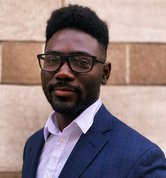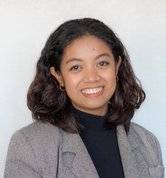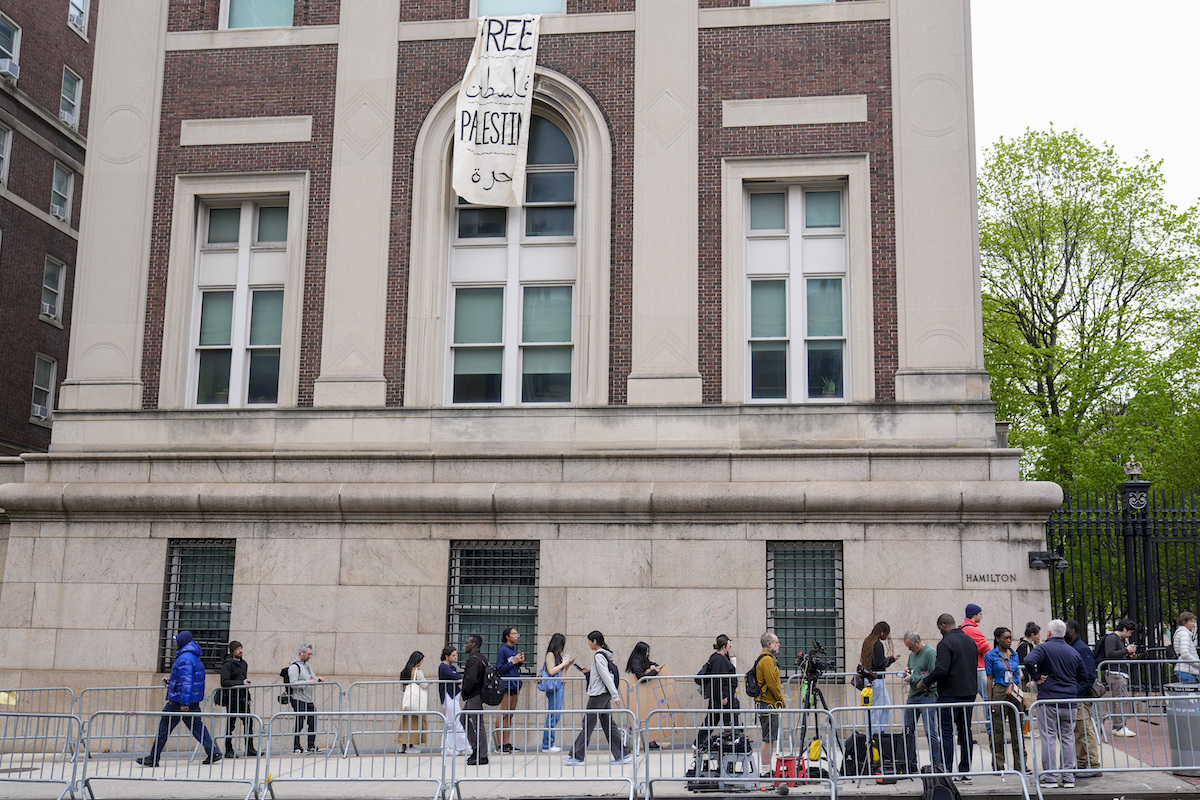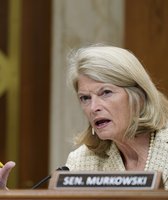Stand up for the facts!
Our only agenda is to publish the truth so you can be an informed participant in democracy.
We need your help.
I would like to contribute
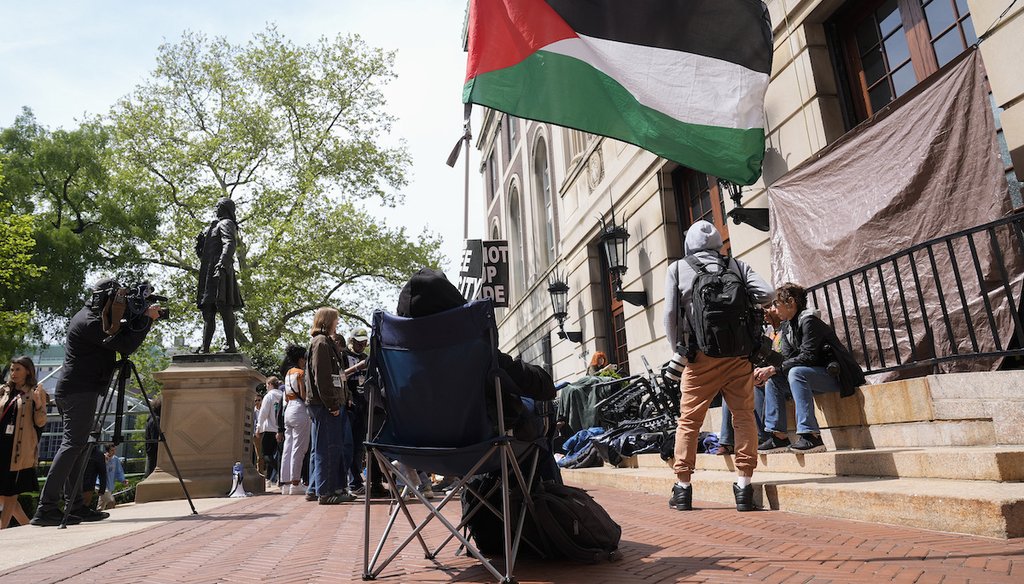
Student protesters camp near the entrance to Hamilton Hall on the campus of Columbia University, April 30, 2024, in New York. (AP)
If Your Time is short
-
Police, city and university officials nationwide have blamed “outside agitators” for campus protests but have provided little evidence for their claims.
-
Law enforcement experts say police often consider “outside agitators” to be people who move from city to city and are paid to be agitators.
-
Historians say government and law officials commonly use the “outside agitator” narrative to delegitimize protesters and their demands.
New York City Mayor Eric Adams, several college and university administrators across the country, and some law enforcement members have blamed "outside agitators" for the disruption in now weekslong pro-Palestinian protests on campuses across the country.
The anti-war student protesters want their universities to disclose ties to Israel and sever all economic and academic ties to Israeli institutions. Other groups have called for university endowments to divest in companies that profit from the Israel-Gaza war.
As protests roiled Columbia University’s campus, Adams has repeatedly cited "outside agitators" for disruption at protests that led to university officials asking city police to intervene.
Among school administrators, Emory University President Gregory L. Fenves apologized for earlier mislabeling a student encampment as the work of outsiders. A University of Florida spokesperson’s claim that protesters arrested on campus were outside agitators was dismissed by faculty union chairperson Meera Sitharam.
Politicians made this claim, too. In an April 25 statement on X, Rep. Hank Johnson, D-Ga., said "outside agitators who seek to usurp the peaceful protests" have no place at the Emory University campus. Rep. Ayanna Pressley, D-Mass., said April 25 that she was concerned about "outside agitators that detract from peaceful solidarity actions."
Sign up for PolitiFact texts
A group of New York Republican lawmakers led by New York Rep. Elise Stefanik wrote an April 22 letter to Columbia University President Minouche Shafik, saying, "Your failure to enforce the rules on campus has created an environment in which students and outside agitators know they are able to operate with impunity and without any accountability."
Former President Donald Trump said May 1 at a Wisconsin rally that identical protest banners and placards were an indication of outsiders controlling the student protesters. "Many of them aren’t even students, you know, and many of them come from foreign countries."
The question: Exactly who are "outside agitators" and what influence have they had over the student protests at Columbia University and elsewhere in the country?
Bob Harrison, adjunct researcher at Rand Corp. who had a 30-year police career, told PolitiFact, "People on all sides of an issue have used the term, both to say that people not directly involved in a protest should join, and by officials using the term to connote that the ‘troublemakers’ were not local or affiliated with the community (or college)."
Law enforcement considers outside agitators "people who get paid to be agitators," said Gerald G. Neill, president of the Association of Retired Police Officers of Washington, D.C. "There is a community of them. … They move city to city or where they get paid to be."
The "outside agitator" term has often been attached to large historical movements.
"It was used as sort of a phrase that would link protesters, no matter how peaceful they were, to Communists and other infiltrators who were causing disruption," said Timothy Zick, William & Mary law professor and author of "Managed Dissent: The Law of Public Protest."
Zick said the term is used by those seeking to discredit protests by casting doubt on the protesters’ sincerity. People who want to cause disorder may show up to protests in public places, like the demonstrations that followed the police killing of George Floyd. Zick said this "unavoidable" aspect of large protests may "give a black eye to the protest movement itself to suggest that it's not peaceful."
"The idea behind the concept of the outside agitator is that dissent can never be coming from the people who are expressing that dissent," said Angus Johnston, historian of student activism and teacher at Hostos Community College in New York City. "There always has to be a shadowy figure behind them."
Students and staff line up outside Hamilton Hall to enter the Columbia University campus, April 30, in New York. (AP)
At Columbia, that "dissent" hit a flashpoint April 30, when police entered the campus and arrested scores of protesters barricaded in a building and at an encampment on the school’s lawn. Police also arrested students at a protest at nearby City College. In all, over 2,000 people have been arrested at universities across the country according to an Associated Press tally.
Columbia’s president wrote to the New York Police Department April 30 requesting assistance, pointing to external actors as leaders of the Hamilton Hall takeover. "We believe that while the group who broke into the building includes students, it is led by individuals who are not affiliated with the University," Shafik wrote.
In a press conference that day, Adams, the New York mayor, said, "I have been saying for days, if not weeks now, that what should have been a peaceful protest, it has basically been co-opted by professionals outside agitators." These external actors, he said, were not students but people who had a history of "escalating situations and trying to create chaos."
To prove their claims, New York Police Department officials pointed to a tactical change or escalation they believe these outside agitators inspired. These tactics included wearing black clothes and face covers like scarves and masks, breaking into windows, building barricades out of furniture and destroying cameras and property. Students broke windows at Hamilton Hall and barricaded themselves inside.
According to a statement from Adams and the NYPD, 32 out of 112 people arrested at Columbia’s private campus were unaffiliated with the university. At nearby City College, a public institution, 102 out of 170 people arrested were not students.
Adams, aiming to buttress his claims about "outside agitators," said May 1 on MSNBC that the NYPD Intelligence Division briefed him on two people, but he declined to give their names so as "not to give notoriety to people who participate in activities like that."
Media outlets identified those people as Lisa Fithian and Nahla Al-Arian. Law enforcement confirmed their names to the media. PolitiFact contacted the NYPD but received no response.
Fithian was not arrested and said she was not on campus when police made arrests, according to The New York Times. She denied to the Times that she was organizing the protests and said she was informally invited to train about 30 student activists about protest safety and logistics.
Al-Arian, the wife of Sami Al-Arian, a former professor who pleaded guilty in 2006 to aiding a terrorist group, was at Columbia’s tent encampment, according to Sami Al-Arian’s April 26 social media post. The New York Police Department found no evidence that she committed any criminal wrongdoing.
Nahla Al-Arian told The Associated Press that Adams "misstated both her role in the protests and the facts about her husband." She said she visited the encampment during an unrelated trip to New York City, and "did not speak directly with any protesters," The Associated Press reported.
Adams has claimed the student protesters were being "influenced by those who are professionals at radicalizing our children."
Angus Johnston, historian of student activism and teacher at Hostos Community College in New York City, said Adams’ statement was "infantilizing."
Some experts have been quick to note the main goal of a protest is to get others to join in.
"If you’re a protester who’s planned it you want all outsiders to join you," said Justin Hansford, executive director of the Thurgood Marshall Civil Rights Center at Howard Law School. "That's the whole point. So that’s why this is such a silly concept."
PolitiFact also fact-checked several claims that philanthropist and Democratic donor George Soros funded the protesters, a claim that resurfaced in the recent campus protests. Two groups linked to the demonstrations received grants from Soros’ Open Society Foundations, but connections between those funds and specific campus protesters were several degrees removed.
The narrative of "outside agitators" leading demonstrations has been pervasive in the history of American protests, going all the way back to the Civil Rights era.
"Segregationists in the South claimed that the protests there were the result of so-called outside agitators, indicating that of course the local population wasn't objecting to racial segregation, which wasn't true in all respects," Zick said. "People use (the term) to discredit protest to indicate that there's something not genuine about the objections people are making."
Martin Luther King Jr. was sometimes branded an outside agitator by local and state officials for his travels to cities and towns to join marches against racial segregation. King rejected this label in his now famous 1963 "Letter From Birmingham Jail,"
"I cannot sit idly by in Atlanta and not be concerned about what happens in Birmingham," King wrote. "Injustice anywhere is a threat to justice everywhere."
But the outside agitator narrative is a tried and tested police tactic, Hansford said. "You have to make their protesters bad before you can expect the public to accept a really violent action against them," said Hansford, who was involved in the 2014 Black Lives Matter protests in Ferguson, Missouri, after the police killing of unarmed Black teenager Michael Brown.
"When I was doing Black Lives Matter protest, we never said we wanted our protest to be something that only Blacks participated in," Hansford said. "It's an imposition of a boundary trying to pigeonhole the protesters in terms of their identity and determine for them who's an outsider to them and who’s an insider to them."
Our Sources
NBC News, Protesters take over Columbia University building hours after school starts suspending student demonstrators, April 29, 2024
CNN, Examining the long history of the ‘outside agitator’ narrative, April 29, 2024
Columbia University Apartheid Divest homepage, accessed May 3, 2024
The Associated Press, Students protesting on campuses across US ask colleges to cut investments supporting Israel, April 24, 2024
X post by Rep. Hank Johnson, April 25, 2024
Congresswoman Ayanna Pressley, Rep. Pressley’s statement on peaceful student protests, April 25, 2024
Rep. Elise Stefanik, Stefanik Leads NY Delegation Letter Calling for Columbia University President’s Resignation, April 22, 2024
April 22, 2024 letter from Republican NY delegation to Columbia University President Minouche Shafik
FOX6 News Milwaukee YouTube video, Former President Donald Trump Wisconsin visit; 2nd trip to swing state | FOX6 News Milwaukee, May 1, 2024
NYC, Transcript: Mayor Adams Briefs Media on Recent Protests at Columbia University With NYPD Commissioner Caban, April 30, 2024
NYC, Transcript: Mayor Eric Adams Briefs Media on Recent Protests at Columbia University With NYPD Commissioner Caban, May 1, 2024
NYC, Transcript: Mayor Adams Appears Live on MSNBC's "Deadline: White House", May 1, 2024
NYC, Transcript: Mayor Adams Appears Live on NY1's "Mornings on 1", May 2, 2024
NYC, Mayor Adams, NYPD Commissioner Caban Provide Additional Details Highlighting Nearly 50 Percent of Columbia/City College Protests Included Unaffiliated Parties, May 2, 2024
Time, ‘Why Are Police in Riot Gear?’: Inside Columbia and City College’s Darkest Night, May 1 2024
ABC 7, Protesters unaffiliated with CCNY, Columbia made up nearly half of arrests: police, May 2, 2024
Cambridge Dictionary, black bloc entry, accessed May 2, 2024
X post by Gloria Pazmino, May 2, 2024
X post by Gloria Pazmino, May 2, 2024
Columbia University, Letter to NYPD - Apr. 30, April 30, 2024
Tampa Bay Times, 9 UF protesters arrested after days of pro-Palestinian demonstrations, April 29, 2024
The Associated Press, At least 2,000 people arrested at pro-Palestinian protests on US campuses, AP tally shows, May 2, 2024
The Associated Press, College protests: More than 2,100 arrested during pro-Palestinian protests on US college campuses, May 2, 2024
New York Post, Notorious anti-Israel protester Lisa Fithian, paid $300 a day to teach activists, spotted among Columbia rioters, May 1, 2024
Fox News, NYPD release video showing professional 'protest consultant' at Columbia University, April 30, 2024
The New York Times, The 63-Year-Old Career Activist Among the Protesters at Columbia, May 1, 2024
NBC News, A veteran activist joined Columbia protesters. Police call her a 'professional agitator.', May 1, 2024
Politico, New York City mayor continues to blame outside agitators for Columbia unrest, but offers little evidence, May 1, 2024
Mother Jones, Meet Professor Occupy, March/April 2012 issue
X post by Sami Al-Arian, April 26, 2024
The Associated Press, A retired teacher saw inspiration in Columbia’s protests. Eric Adams called her an outside agitator, May 1, 2024
Columbia University, A New Perspective on 1968, Published April 2018
Emory University, Campus Update, April 29, 2024
The Associated Press, Timeline of events in shooting of Michael Brown in Ferguson, August 8, 2019
PolitiFact, Fact-checking claims that George Soros is ‘paying student radicals’ involved in campus protests, May 2, 2024
University of Pennsylvania African Studies Center, "Letter from a Birmingham Jail [King, Jr.]"
Email exchange with Bob Harrison, adjunct researcher for RAND Corp., May 3, 2024
Email exchange with Gerald G. Neill, president of the Association of Retired Police Officers of Washington DC, May 3, 2024
Phone interview with Timothy Zick, William and Mary law professor, May 2, 2024
Phone interview with Justin Hansford, executive director of the Thurgood Marshall Civil Rights Center at Howard Law School, May 2, 2024
Phone interview with Angus Johnston, historian of student activism and teacher at Hostos Community College in New York City, May 2, 2024
Email exchange with Cathy Schneider, professor at American University who specializes in comparative social movements, May 2, 2024
